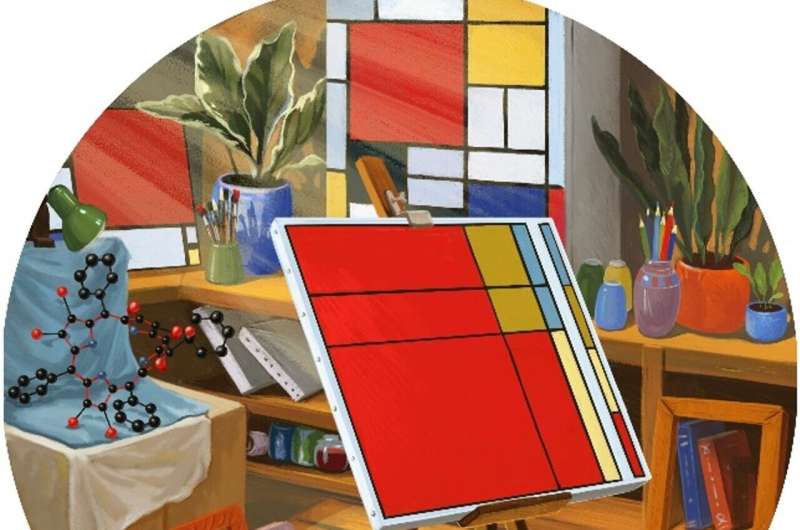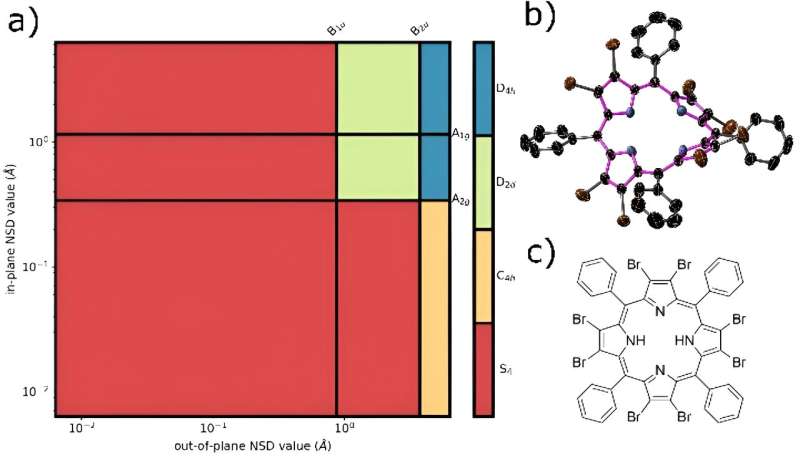
An example of a visual, Mondrian-like result obtained by a computer program for a particular molecule. Credit: Prof. Mathias O Senge, Trinity College Dublin.
Scientists at Trinity College Dublin have created a computer program that “paints” the structure of molecules in the style of famous Dutch artist Piet Mondrian, whose magnificent works of art will be instantly recognizable to many.
Mondrian’s style of using blocks of primary colors separated by lines of different widths on a white background has been widely copied or used as inspiration in modern culture. But his deceptively simple artworks have also fascinated scientists for decades, finding niche applications in mathematics and statistics.
And today, researchers in the School of Chemistry are opening eyes and minds to the beauty of molecular structure, while asking new questions about the form and function of molecules themselves.
Their computer program, available at http://www.sengegroup.eu/nsd, produces a Mondrianian tracing of any molecule. It does so by following an artistic algorithm that combines the laws of chemistry describing the 3D structure of a molecule in terms of its components with the 2D style of one of the most influential painters of the modern era.
For the scientist, it allows for a rapid assessment and demonstration of molecular symmetry, yielding deeper insights than would emerge from traditional representations. And for the artist, it provides a visually pleasing image of contrasting interpretations of symmetry, which will hopefully inspire the integration of scientific ideas into their work.
Mathias O Senge, professor of organic chemistry at Trinity and Hans Fischer Senior Fellow at the Institute for Advanced Study at TU Munich, is the lead author of a paper in the journal, applied chemistryin which this creation is shared with the world.
He said: “We have been working on this project for a few years, initially for fun, to reproduce the structure of a molecule in an artistically pleasing way as a painting in the style of Mondrian. The resulting ‘paintings’ are unique for each molecule and juxtapose what Mondrian and others were trying to do with the De Stijl art movement.
“Symmetry and shape are essential aspects of molecular structure and how we interpret molecules and their properties, but very often the relationships between chemical structure and derived values are obscured. Taking inspiration from Mondrian’s Compositions, we represented the symmetry information encoded in the 3D data as blocks of color, to clearly show how chemical arguments can contribute to symmetry.”

(a) “Neoplastic” diagram of the porphyry core of classical non-planar 2,3,7,8,12,13,17,18-octabromo-5,10,15,20-tetraphenylporphyrin (CCDC: RONROB), accompanied by two representations of this same molecule: (b) the thermal ellipsoid plot of the crystal structure and (c) the skeletal model. This form of porphyrin is mainly saddle and somewhat ruffled, which gives an S shape4 symmetry. Credit: applied chemistry (2024). DOI: 10.1002/ange.202403754
Christopher Kingsbury, a postdoctoral researcher at TBSI who designed the project, is the first author of the journal article.
He said: “In chemistry, it is useful to have a universal way of displaying molecular structure, to help ‘plan’ how a molecule is likely to behave in different environments and how it might react and change shape in the presence of other molecules. But a certain amount of nuance is inevitably lost.
“This concept of increasing abstraction by removing minor details and trying to present a general form is imitated by Mondrian’s early work and, in a sense, is what scientists intuitively do when they reduce complex phenomena to a ‘simpler truth’. With our new approach, very complex sciences are fed through an artistic prism, which could make them more accessible to a wider range of people.”
In recent years, Professor Senge and his team have significantly advanced our understanding of porphyrins, a unique class of intensely colored pigments, also known as the “colors of life.” In one of their research projects, they created a series of new biological sensors by chemically re-engineering these pigments to act like tiny Venus flytraps and capture specific molecules, such as pollutants. And this new direction, where science and art meet, could deepen our understanding of how porphyrins work.
“Great works of art give us a new perspective on the world,” added Professor Senge. “As a pastiche, these works of art can allow us to look at familiar molecules, such as porphyrins, in a new light, and help us better understand how their shape and properties are closely related.”
“More generally, we believe that contemporary initiatives in the field of art and science require a radical breaking of the boundaries between disciplines and a fusion towards art and science. There is a subtle interplay between science and art and a blending of the two aspects in our respective fields of activity, and this should be a goal for future developments in both fields.”
More information:
Christopher J. Kingsbury et al., Molecular Symmetry and Art: Visualizing the Near-Symmetry of Molecules in Piet Mondrian’s De Stijl, applied chemistry (2024). DOI: 10.1002/ange.202403754
Provided by Trinity College Dublin
Quote:Scientists create computer program that ‘paints’ structure of molecules in style of famous Dutch artist (2024, July 12) retrieved July 14, 2024 from https://phys.org/news/2024-07-scientists-molecules-style-famous-dutch.html
This document is subject to copyright. Apart from any fair dealing for the purpose of private study or research, no part may be reproduced without written permission. The content is provided for informational purposes only.